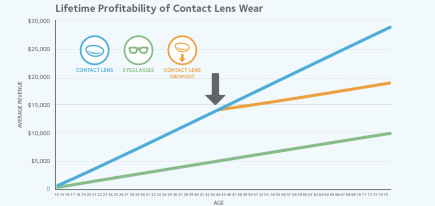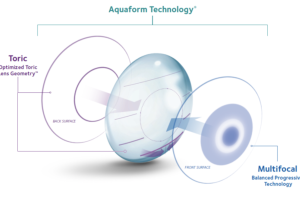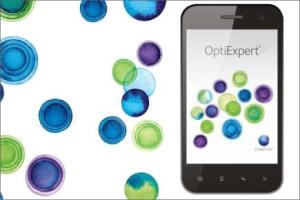Continuous advancements in contact lens technology have enabled eye care professionals to fit more patients than ever—and keep patients wearing lenses successfully for longer. New lens designs are reaching segments of the population who have been waiting for options that provide superior comfort and visual acuity. One such group of patients are astigmatic presbyopes, who offer practitioners significant opportunity to grow their contact lens practices.
OPPORTUNITY IN PRESBYOPIA

The population is aging, and people are living longer. As a result, people in the Western World will spend almost half of their lives as presbyopes.1 Currently, more than 40 million Americans are approaching the age at which symptoms of presbyopia typically begin, and another 40 million are right behind them.2
At the same time, the percentage of people wearing contact lenses in the United States decreases significantly after the age of 40. A survey showed that only 37% of patients over the age of 45 are prescribed contact lenses, with multifocals accounting for just 29% of those fits.3 Undoubtedly, a sizeable proportion of the general population could potentially benefit from multifocal contact lenses as new wearers upon reaching presbyopia. In addition, there are many millions of existing lens wearers who drop out as they enter into presbyopia who could be retained.
Research shows that many presbyopic patients would like to wear contact lenses, but they don’t understand their options. In a survey of adults who required vision correction, spectacles were the primary vision correction for 78% of the subjects.4 Yet presbyopes of all refractive errors said they preferred contact lens correction, assuming that good vision and comfort could be achieved.4 In another survey, a mere 4% of participants reported being counseled by their optometrists about multifocal contact lenses.5
These trends reveal opportunities for optometry practices to recapture lost revenue while also giving patients the quality of vision—and lifestyle—they deserve.
OPPORTUNITY IN ASTIGMATISM
We know that astigmatism is a very common refractive error for people of all ages, including middle-aged and older adults who are presbyopes. Globally, approximately 40% of adults have astigmatism, and this figure may be as high as 46% in the Americas.6
Typically, astigmatism is uncorrected in many contact lens wearers. While nearly 50% of this group has astigmatism of 0.75D or greater in at least one eye,7 only 30% of contact lenses are prescribed for astigmatism.8 This practice is unfortunate because uncorrected astigmatism is a substantial cause of poor vision and a major barrier to contact lens use in presbyopes. Decreased acuity and symptoms of eye strain can occur from uncorrected astigmatism as low as 0.75D,7 and visual satisfaction is critical for overall patient satisfaction and success when prescribing multifocals.
With distance vision alone, studies have shown significant gains in acuity when correcting with toric contact lenses. In fact, by fitting a patient in toric lenses versus spherical lenses, between 3 and 5.5 extra letters of distance acuity can be achieved in low astigmatic eyes, and between 8 and 12.5 letters in moderate astigmatic eyes.9,10 These improvements are likely to increase the chances of success for astigmatic presbyopes when a toric component is incorporated into a multifocal contact lens design.
THE CHALLENGES OF ASTIGMATIC PRESBYOPES
Of course, there are traditional vision correction options for astigmatic patients with presbyopia—but they often have shortcomings. Adding reading glasses while continuing to wear contact lenses for distance vision can be inconvenient and cumbersome, and completely switching from contact lenses to glasses may make wearers feel less confident about their appearance or limited in their activities. For some wearers, refitting with monovision contact lenses can result in suboptimal binocular vision performance. And multifocal toric contact lenses have been historically difficult to fit with inconsistent performance from lens to lens.
Understandably, eye care professionals and astigmatic presbyopes are tired of making compromises. Correcting for astigmatism and presbyopia in a single contact lens has traditionally been complex, but after years of design and development, CooperVision has changed the game with Biofinity® toric multifocal.
THE SOLUTION THAT CAN HELP BUILD YOUR PRACTICE
With more than a third of existing toric contact lens wearers are 40+ years old and nearing or already experiencing presbyopia11, now is the time to adopt a toric multifocal lens you can count on. The ability to provide an effective and comfortable contact lens option for patients who have both astigmatism and presbyopia can help grow your patient base and increase revenue. Multifocal contact lens wearers can be one of the largest sources of profit in an optometric practice,12 and contact lens wearers return for routine care more frequently than non-contact lens wearers.13

By slowing down a potential source of dropout as existing toric lens wearers age into presbyopia—and reaching a segment of patients who perhaps believed they couldn’t wear contact lenses—you can set your practice apart. Don’t miss the opportunity to help successfully transition your astigmatic patients into their presbyopic years with Biofinity® toric multifocal.
References
1. Dentone P, Afshari N. Presbyopia. American Academy of Ophthalmology website. October 19, 2019. https://eyewiki.aao.org/Presbyopia. Accessed September 8, 2020.
2. U.S. Census. 2018 American Community Survey Demographic and Housing Estimates. Table DP05. https://data.census.gov/cedsci/table?q=United%20States&g=0100000US&tid=ACSDP1Y2018.DP05. Accessed September 8, 2020.
3. Morgan PB., Efron N, Woods CA. An international survey of contact lens prescribing for presbyopia. N Clin Exp Optom. 2011 Jan;94(1):87-92
4. Rueff EM, Bailey MD. Cont Lens Anterior Eye. 2017;40(5):323-328.
5. Hutchins B, Huntjens B. J Optom. 2020 April 4. [Epub ahead of print]. doi: 10.1016/j.optom.2020.02.001.
6. Hashemi H, et al. J Curr Ophthalmol. 2018;30(1):3-22.
7. Young G, et al. Eye Contact Lens. 2011;37(1):20-25.
8. Efron N, et al. Optom Vis Sci. 2015;92(7):758-767.
9. Richdale K, Berntsen D, Mack C, Merchea M, Barr Joseph. Visual acuity with spherical and toric soft contact lenses in low- to moderate-astigmatic eyes. Optom Vis Sci. :2007; 84(10): 969-75
10. DA Berntsen, SM Cox, KM Bickle, JH Mathew, DR Powell, SH Seidman, BK Little, KO Lorenz, JJ Nichols. A randomized trial to evaluate the effect of toric versus spherical contact lenses on vision and eyestrain. Eye Contact Lens 2019. 45(1)28-33.
11. CVI data on file, 2019, U.S., Industry reports and internal estimates of toric contact lenses from 4 main manufacturers
12. Karpecki, P., & Gaddie, I. B. (2016, July 01). Reviews Supplements A GAME-CHANGING APPROACH TO HELP OVERCOME CONTACT LENS DROPOUT. Retrieved October 10, 2020, from http://bt.e-ditionsbyfry.com/publication/?i=317710
13. Efron N, Morgan PB. Rethinking contact lens aftercare. Clin Exp Optom. 2017 Sep;100(5):411-431. doi: 10.1111/cxo.12588. Epub 2017 Sep 4. PMID: 28871604.








